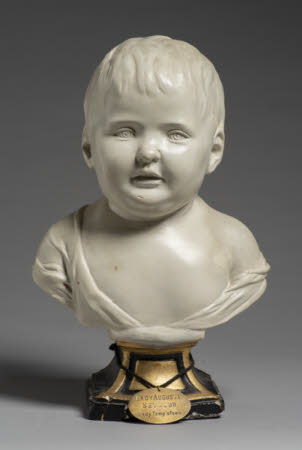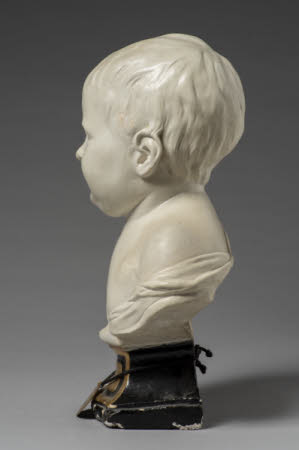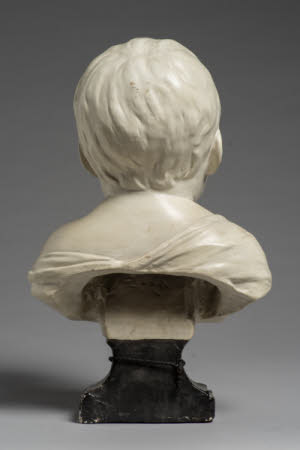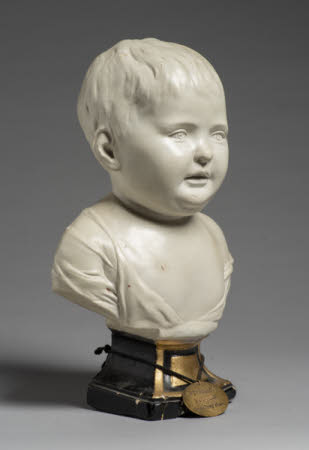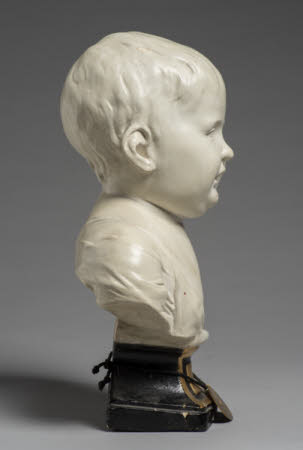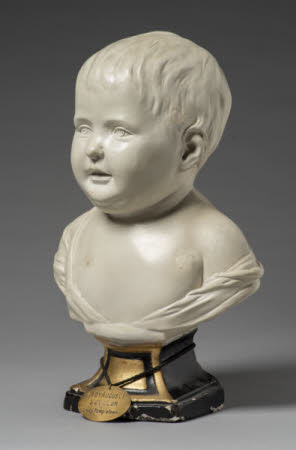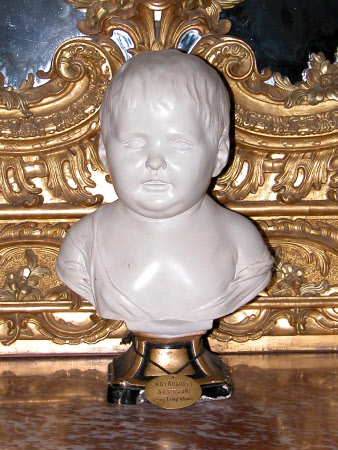Portrait of Lady Augusta Hervey as an infant
Elizabeth Boughton, Lady Templetown (1747 - 1823)
Category
Art / Sculpture
Date
c. 1799 - 1800
Materials
Plaster
Measurements
37 x 25 cm
Place of origin
London
Order this imageCollection
Ickworth, Suffolk
NT 852216
Summary
Sculpture, painted plaster; Portrait bust of Lady Augusta Hervey, later Lady Augusta Seymour (1798-1880), as a small child; Elizabeth Upton, Lady Templetown (1747-1823); Ickworth or London, c. 1799-1800. One of three busts at Ickworth depicting Augusta Hervey and her younger brother Frederick William Hervey, later 2nd Marquess of Bristol (1800-1864) when they were very small children, sculpted by their grandmother Elizabeth Upton, Lady Templetown, a talented amateur artist who is best-known today for the designs she supplied to Josiah Wedgwood.
Full description
A painted plaster portrait bust of Lady Augusta Hervey (1798-1880), depicting the sitter at the age of around one. Augusta is shown facing frontally, her mouth slightly open, wearing a dress that has slipped slightly off her left shoulder. The bust is on a rectangular base, flat at the back and bowed at the front. The plaster is painted white except for the base, painted black and gold. Around the base is a brass label on a cord. The sculpture was repaired in 1976. This is one of three remarkable portrait busts at Ickworth, sculpted by Elizabeth Upton, Lady Templetown (1747-1823), which depict the two eldest of her grandchildren at very early stages in their lives. Elizabeth Upton was one of a small group of well-born women living in the second half of the eighteenth century who were able, to varying degrees, to make use of their considerable artistic talents by pursuing careers as amateur artists. Others included Diana, Lady Beauclerk (1734-1808) and the Honourable Anne Seymour Damer (1748–1828). Like Diana Beauclerk, Elizabeth Upton is best known today for the designs she made from 1783 for Josiah Wedgwood and delivered in the form of paper cut-outs, which were then modelled up in the factory and reproduced on Wedgwood wares (Hughes 1952). Born into a gentry family in Herefordshire, in 1769 Elizabeth Boughton married Clotworthy Upton (1721-85), a courtier who in 1776 was created Baron Templetown of Templetown, Co. Antrim and who died in 1785, leaving Elizabeth a widow with a son and three daughters. Some of the couple’s wealth may have derived from slavery; Lord Templetown owned estates and enslaved people on Grenada which, on his death in 1785, he bequeathed in trust for his wife for life, although her later life does not appear to have been a very wealthy one. The only sculptures by Elizabeth Upton currently known are all at Ickworth, but she seems to have begun to sculpt from an early age. In 1773 she travelled with her husband to Italy, where they remained until 1775. The sculptor Richard Hayward recorded the couple in Rome in 1774, noting that ‘Mrs Upton models in Clay and wax’ (Stainton 1983, p. 15). The Uptons must have come to know Giovanni Battista Piranesi (1720-78), who in dedicating to Elizabeth Upton a plate of his great compilation ‘Vasi, candelabri, cippi, sarcofagi, tripodi, lucerne ed ornamenti antichi’, published in 1778, was fulsome in his praise for her learning: ‘To Mrs Eliza Upton, English Lady and most learned in every conceivable field of the liberal arts’(‘Alla Signora Eliza Upton Dama Inglese Intendentissima in ogni sorta di Arti Liberali’). Accompanied by her three daughters, Elizabeth Upton returned to Italy as a widow late in 1792, remaining for the next three years. In February 1798 her youngest daughter Elizabeth Albana Upton (1775-1844) married Frederick William Hervey, later 5th Earl and 1st Marquess of Bristol (1769-1859). Their first child, Lady Augusta Hervey (1798-1800), was born on 8 September 1798. The portrait of Augusta, which shows her at about one year old, is an excellent study of childhood, the head still slightly too large for the tiny shoulders, the face with an expression of innocent amiability. Elizabeth Upton made a similar portrait of Augusta’s brother Frederick William Hervey, later 2nd Marquess of Bristol (1800-1864), which survives in two versions, in marble and plaster (NT 852217.1 and 852217.2). It shows him perhaps a little older, around two or three. In making these sculptures of her grandchildren, the sculptor demonstrated her awareness of both older and contemporary prototypes. She must have known examples of the charming busts of small children made by the Florentine sculptor Desiderio da Settignano (c. 1430-1464), some of which would have been visible in public locations in Florence, for example the bust of the young Christ now in the National Gallery of Art, Washington D.C., recorded in 1756 as displayed in the Oratorio of the Vanchetoni next to the church of San Francesco (Desiderio 2007, pp. 168-71, no. 10). The shoulder-length format is derived from Desiderio, as is the slip of clothing around the bottom edge of the bust. From her own lifetime, Elizabeth Upton would surely also have known versions of the French sculptor Jean-Baptiste Pigalle’s extraordinary sculpture of Armand-Louis Joseph Pâris de Montmartel as a one-year old child, exhibited at the Paris salon in 1749, but popular throughout the remainder of the century in the form of bronze versions, one in the Ashmolean Museum, Oxford (Warren 2024, no. 85). Another French sculptor, Elizabeth Upton’s near exact contemporary Jean-Antoine Houdon (1741-1828), made a series of portrait busts of children, including his sparkling portrait of his ten-month old daughter Sabine or that of another daughter Anne-Ange (Scherf 2008, nos. 31, 33, 34). Whilst Elizabeth Upton’s child portraits do not match the brilliance and insight of Houdon, they are sensitive and very well-modelled images of first childhood. At Ickworth, the bust of Augusta Hervey is displayed close to one of the two portrait busts of her as a young woman made nearly two decades later in Florence, in 1818 or 1819, by Lorenzo Bartolini (NT 852215). Lady Augusta Hervey was the eldest of the nine children of Frederick William Hervey, later 5th Earl and 1st Marquess of Bristol (1769-1859) and his wife Elizabeth Albana Upton, Marchioness of Bristol (1775-1844). Her younger brother Frederick William (1800-1864) would become 2nd Marquess of Bristol on his father’s death. After the Hervey family had returned from a four-year long Continental sojourn, Lady Augusta appears from time to time in newspaper reports of balls and other social events, often in the company of her parents and her sister Lady Georgina (for example, Bury and Norwich Post, 16 October 1822). She must though have resigned herself to spinsterhood when in 1832, at the age of 34, she married Frederick Charles William Seymour (1797-1856), henceforth being styled Lady Augusta Seymour. The couple had six children and lived in Brighton from 1832 to 1847, at the Hervey house in Sussex Square. Jeremy Warren July 2025
Provenance
Part of the Bristol Collection. The house and contents were acquired through the National Land Fund and transferred to the National Trust in 1956.
Makers and roles
Elizabeth Boughton, Lady Templetown (1747 - 1823), sculptor
References
Hughes 1952: G. Bernard Hughes, ‘Lady Templetown’s designs for Wedgwood’, Country Life, 26 Sept 1952, pp. 926-27 Desiderio 2007: Marc Borman, Beatrice Paolozzi Strozzi and Nicholas Penny, eds., Desiderio da Settignano. Sculptor of Renaissance Florence, exh. cat. National Gallery of Art, Washington D.C. 2007 Scherf 2008: Guilhem Scherf, Houdon at the Louvre. Masterworks of the Enlightenment, exh. cat., High Museum of Art, Atlanta 2008. Roscoe 2009: I. Roscoe, E. Hardy and M. G. Sullivan, A Biographical Dictionary of Sculptors in Britain 1660-1851, New Haven and Yale 2009, p. 1228, no. 2. Warren 2024: Jeremy Warren, The Beauty of Bronze, Oxford 2024 Conroy, Rachel, Women Artists and Designers at the National Trust, 2025, p. 80
